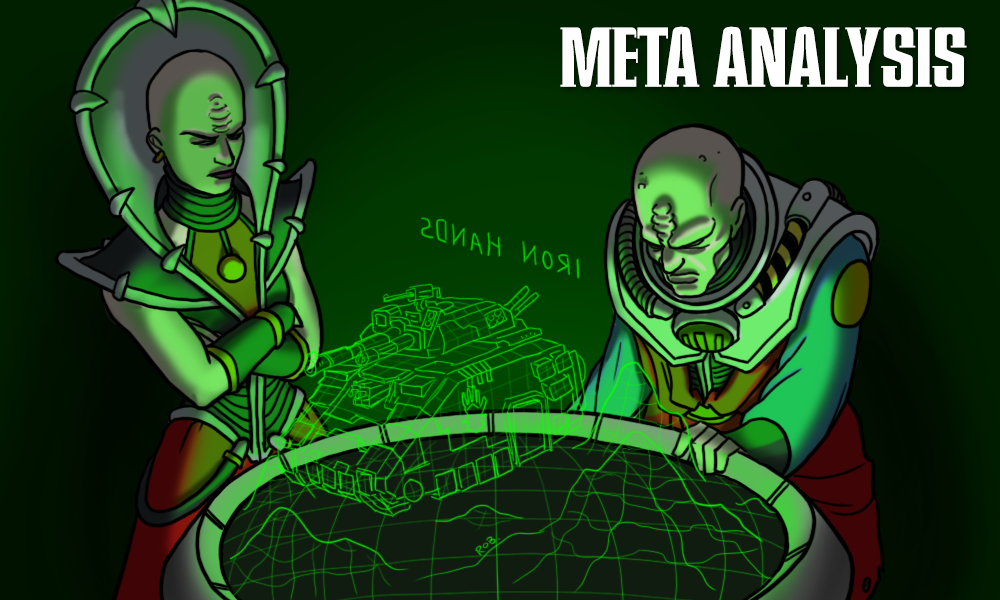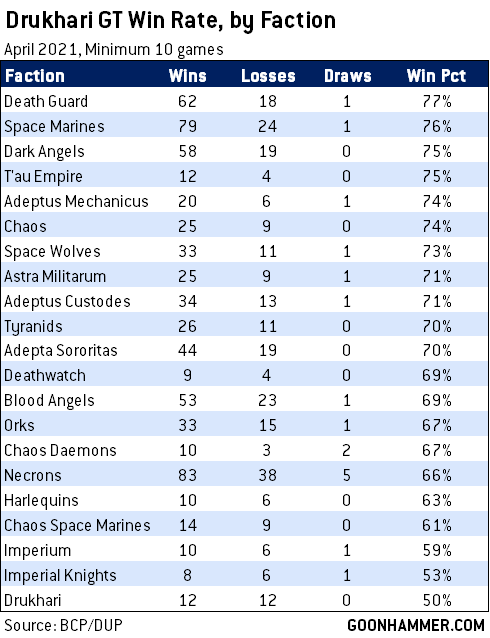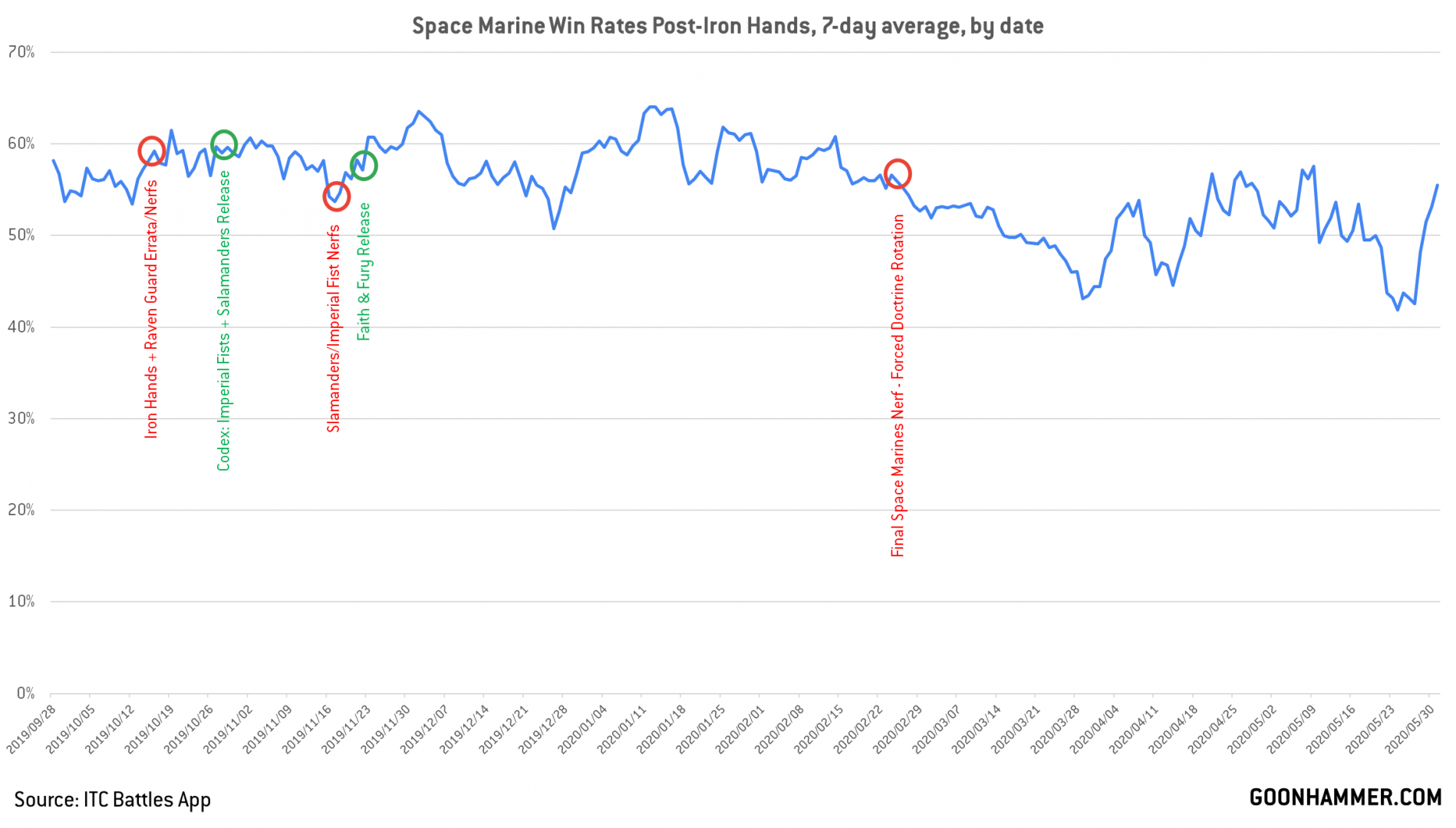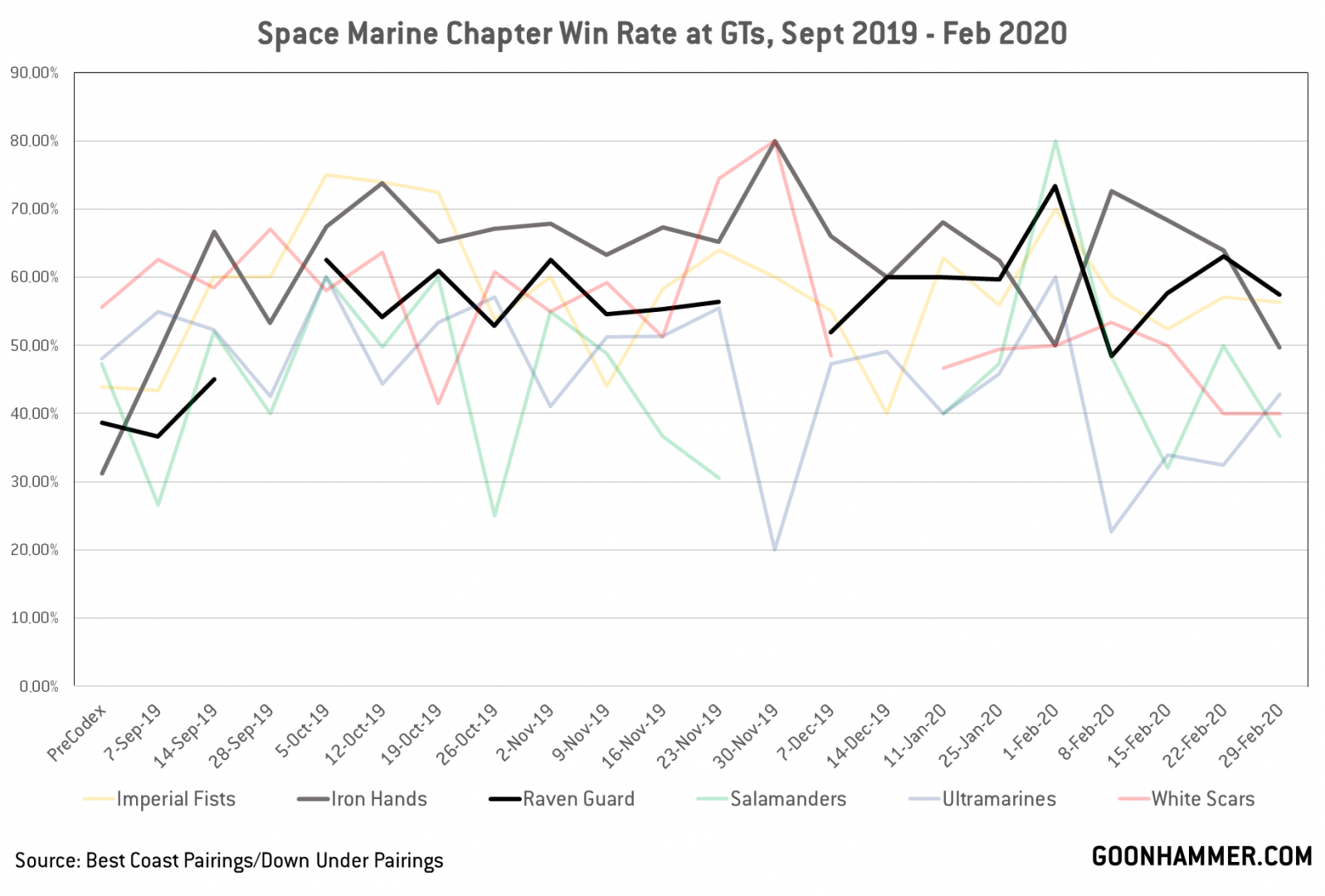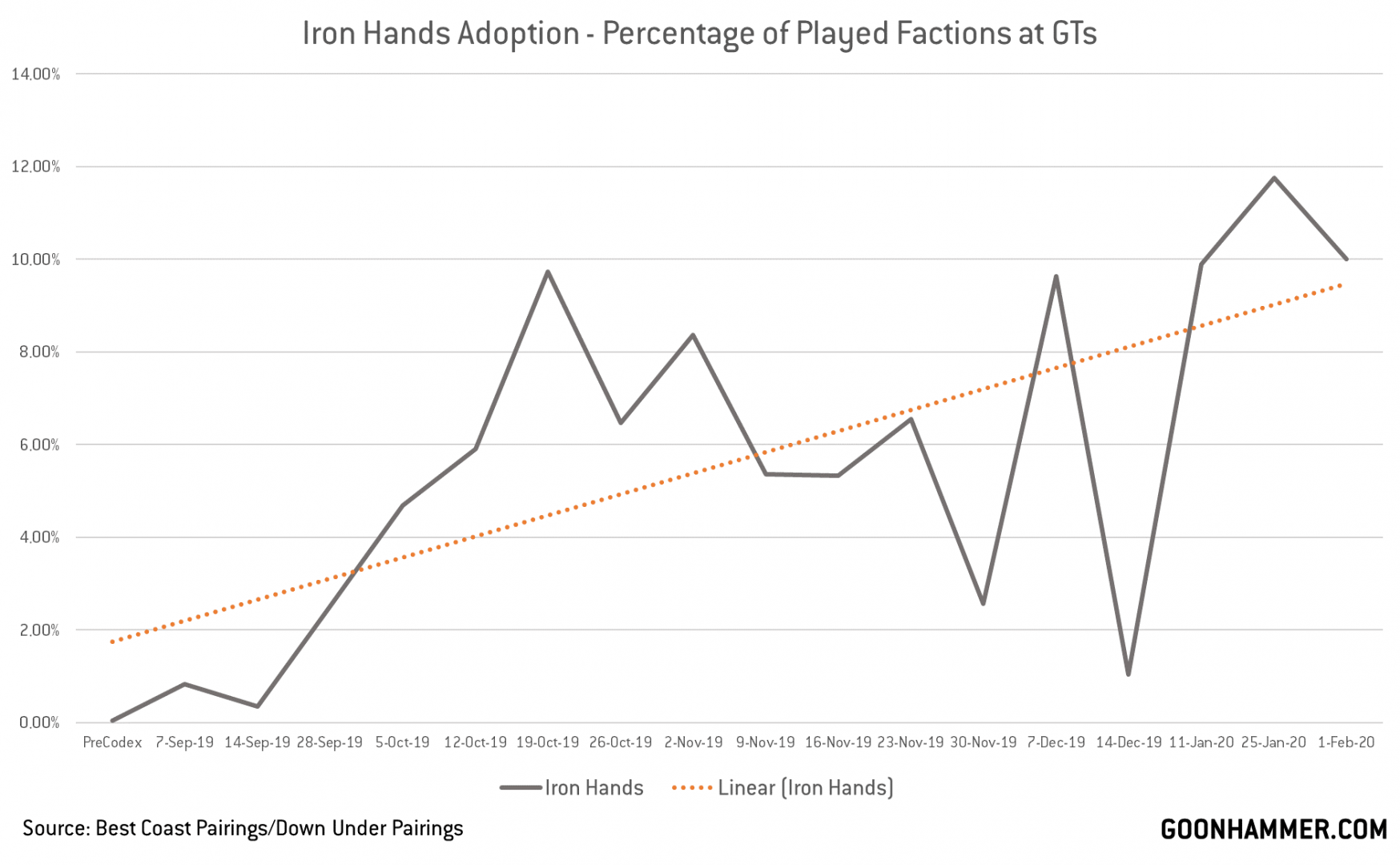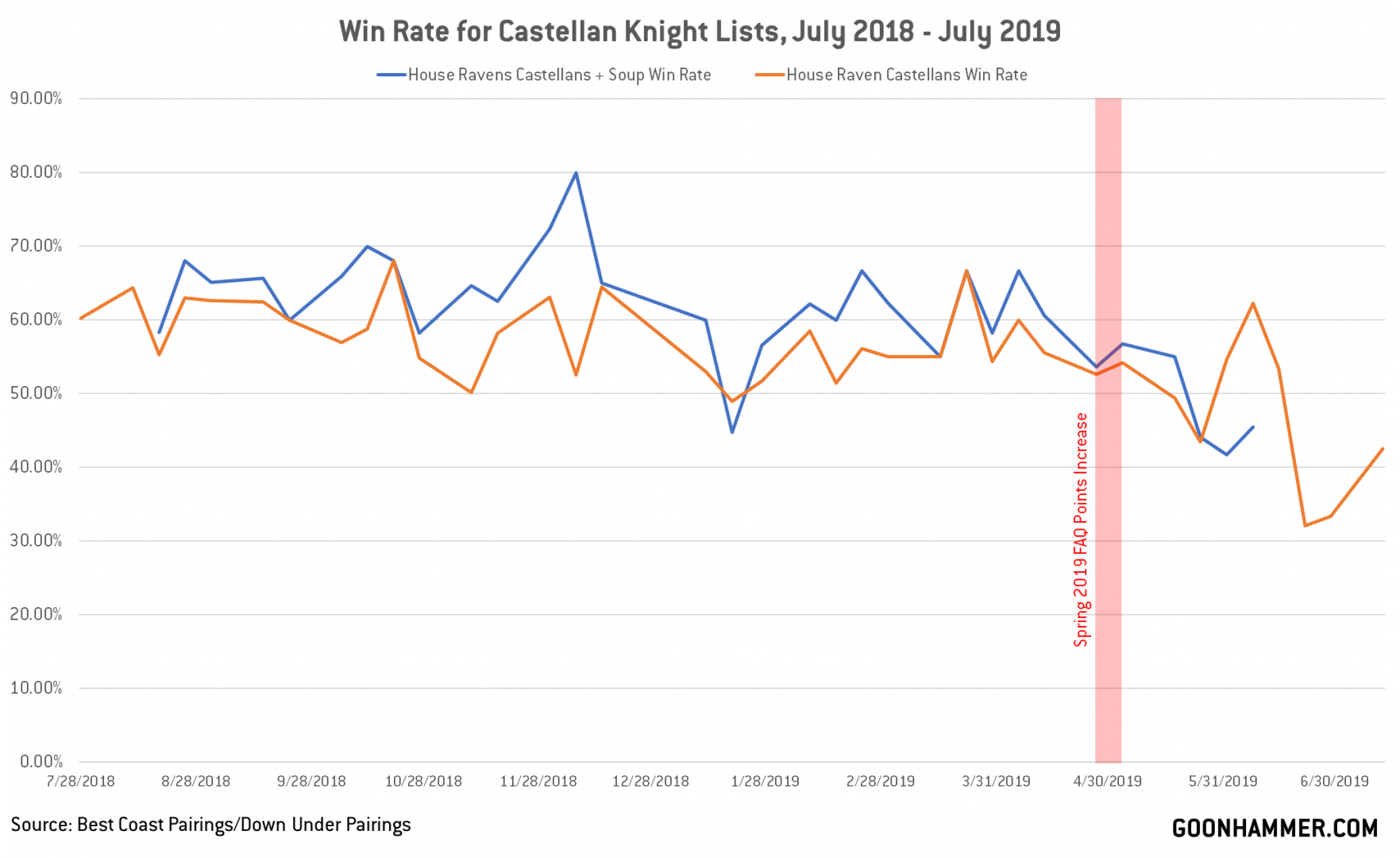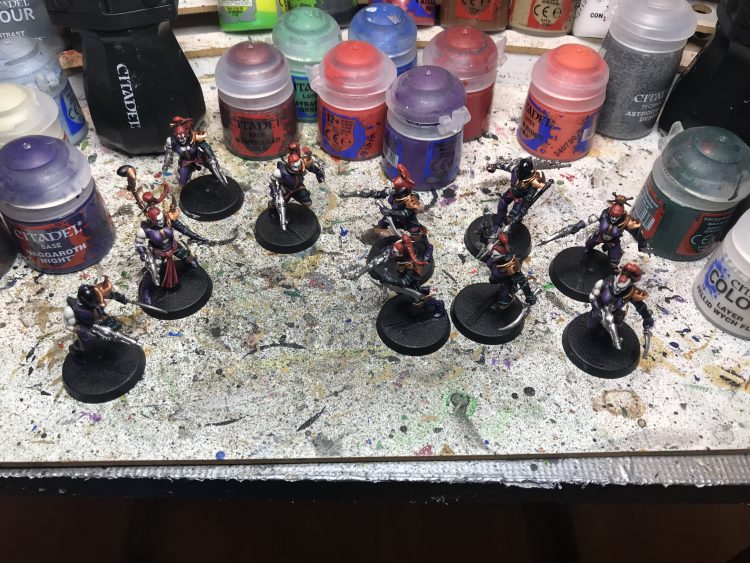Welcome back, dear reader! It’s been a little over a month since our last update and while the Games Workshop release schedule has certainly slowed, we’ve got some massive changes to talk about. You may have seen our round table last week discussing the new Drukhari book, or Wings’ comments on the book in this week’s Competitive Innovations in 9th article or his editorial on what needs to be done. The short version is that Drukhari are really, really good – potentially meta-warpingly good. And today we’re going to be examining their impact and what it means for competitive play by digging deep into the stats behind their ascendancy and looking at historical comparisons.
Methodology
Thanks to the wonderful efforts of tournament organizers and app developers around the world, we have access to what is essentially every meaningful piece of data around competitive games of 40k. The data in this month’s study comes from:
- Best Coast Pairings/Down Under Pairings apps, the premier way to run, manage, and track results for tournaments
- The ITC Battles App, a brilliant app for tracking games both in and out of tournaments and a great source of casual game data worldwide
We’re also joined by Peter “The Falcon” Colosimo of the wonderful site 40kstats.com, who is helping us out with some analysis around what meta adjustments look like.
As vaccination programs have rolled out across the United States and Europe, we’re now seeing an explosion of new events and tournaments, giving us a ton of new data to look at, both in the ITC Battle app and form Best Coast Pairings.
What We’re Covering This Month
Look, even if you hadn’t seen my preview notes in last week’s round table, you should have seen this coming. Today we’re going to primarily cover the meta impact of Codex: Drukhari. We’re going to talk about how dominant the army is, what kind of changes we’ve seen as a result, and whether it’s possible for things to improve without an FAQ, rules change, or new Codex release to shift things. We’re going to dig deep into past examples of dominant factions to answer the question “can the meta adapt?” And we’ll be talking a bit about Dark Angels and what’s on the horizon.
So What Happened?
![]() Rob: Let’s start by talking about the results. Codex: Drukhari released on March 27th, meaning that our first events with the new book started happening two weeks later, on April 10th. While GTs largely adopted the adjusted points value on Reavers from the FAQ we got to the Munitorum Field Manual earlier in the year, Drukhari still proved to be insanely strong out of the gate.
Rob: Let’s start by talking about the results. Codex: Drukhari released on March 27th, meaning that our first events with the new book started happening two weeks later, on April 10th. While GTs largely adopted the adjusted points value on Reavers from the FAQ we got to the Munitorum Field Manual earlier in the year, Drukhari still proved to be insanely strong out of the gate.
Since that first weekend, there have been 11 events of GT size or larger (28+ players, 5+ rounds). Of those, players running Drukhari have won 7 of them (64%).
- Fabricator’s Forge 5 (4/10) – Drukhari win, taking 1st and 2nd place.
- Ratcon 2021 (4/10) – Drukhari win
- Motor City Mayhem (4/24) – Drukhari win
- War of the Wooden Spoon (4/24) – Drukhari win
- Spring Up GT (4/24) – Drukhari win, taking 1st and 2nd place
- Dead Primarch GT (4/24) – Drukhari win
- Dallas GT (5/1) – Drukhari win, taking 1st through 5th place
While Drukhari started off a little slow, they’ve gained steam quickly, taking all five of the top five spots at the 8-round Dallas GT (including one list that was majority Drukhari but included some Craftworlds units). Wings already spoke at length about these lists and what they have in common in his most recent Competitive Innovations in 9th article.
 Falcon: Essentially since the Space Marine and Necron codexes dropped, the 9th edition competitive scene has been fairly varied. While armies like Necrons, Death Guard, and Dark Angels saw some big lifts in representation in the field and win rate, their codexes more or less just put them in the running rather than edged out the early edition top dogs of Sisters, and Harlequins and others (though they did appear to muscle Daemons down into a more middling position). These factions came out in the low 50th percentile for win rates and have pulled off a handful of top 4s but nothing as eye-watering as this.
Falcon: Essentially since the Space Marine and Necron codexes dropped, the 9th edition competitive scene has been fairly varied. While armies like Necrons, Death Guard, and Dark Angels saw some big lifts in representation in the field and win rate, their codexes more or less just put them in the running rather than edged out the early edition top dogs of Sisters, and Harlequins and others (though they did appear to muscle Daemons down into a more middling position). These factions came out in the low 50th percentile for win rates and have pulled off a handful of top 4s but nothing as eye-watering as this.
Rob: At this point, whether you look at win rate or the ELO-like Glicko scores, Drukhari are as far ahead of the next best factions – Sisters of Battle and Harlequins – as those factions are ahead of Genestealer Cults and Tau, the game’s worst factions. Drukhari won a whopping 71% of their recorded ITC Battles App games in April, 15 points more than Harlequins, the next-highest faction. Excluding mirror match games, Drukhari players won more than 79% of the games in which they had the first turn, and won more than 66% of the games in which they went second.
Drukhari win rates started climbing in January, when the faction got some notable points buffs from the January FAQ update that gave us the Codex’s points values two months before its release, improving some units substantially. This also introduced 10-point Reavers, which some players took advantage of immediately before costs were eventually corrected via FAQ. Once the Codex released, their rise has been meteoric, far outstripping the bumps seen for Death Guard or Necrons. Note that games recorded in the ITC Battles app tend to reflect new releases and rules adjustments much earlier than tournaments, as they include practice games that don’t need to wait two weeks.
That said, Drukhari are not the only faction to see their win rates improve as a result of a codex release, though we can see from the chart above that Death Guard’s improvement, while significant, was nowhere near the same level. Still, one major impact that we need to consider is that as factions get new books, they become more popular, and take on a number of new players, likely with varying skill levels. We can take this into account by looking at the share of total wins and losses for a faction to get an idea of how a faction’s performance scales against its popularity. If we compare this to the changes in win/loss share for the last two major codex releases – Necrons and Death Guard – we can see that while those factions rose in popularity and took a greater share of total wins, they also saw an increase in recorded losses as well. Comparatively, while the share of wins for Drukhari have skyrocketed, there’s been only a small increase in the share of losses.
From a head-to-head standpoint, there’s no faction that wins even 50% of its games against Drukhari in either the ITC Battles data from April nor the at GTs when we consider tournament data from BCP/DUP, and most factions have win rates below 35% against Drukhari.
By 40kstats’ outstanding Tournaments in Winning Position metric, Drukhari stats have skyrocketed to astronomical numbers not seen since the days of Iron Hands, and have been in position to win one third (32.5%) of tournaments in 2021, with an average first loss after 2.81 games – and that includes the months of 2021 prior to the release of the current codex.
Falcon: Just to put some perspective on this. Iron Hands at their peak sat around a 30% TiWP and a 2.9 average first round loss. Marines as a whole made up just over 40% in that regard.
Will the Meta Adjust?
![]() One common refrain we hear when presenting these results is that the game’s good players – and the meta as a whole – will adjust to this new strength from the Drukhari faction, and will build armies to counteract what they bring to the table. This should mean that, over time, the Drukhari will become much less dominant as more players win games against them with non-Drukhari armies. As a result, we should expect to see win rates for the Drukhari decline, dropping to more “stable” levels as players figure out how to beat the faction and adapt to its tricks.
One common refrain we hear when presenting these results is that the game’s good players – and the meta as a whole – will adjust to this new strength from the Drukhari faction, and will build armies to counteract what they bring to the table. This should mean that, over time, the Drukhari will become much less dominant as more players win games against them with non-Drukhari armies. As a result, we should expect to see win rates for the Drukhari decline, dropping to more “stable” levels as players figure out how to beat the faction and adapt to its tricks.
Unfortunately, we need only look at the last time something like this happened to understand why that mindset is wrong.
Let’s Talk About Iron Hands
Rob: The second version of Codex: Space Marines was released on August 17th, 2019 along with two Supplements: Ultramarines and White Scars. This just missed the cutoff date for the NOVA 2019 Major event, but were early enough to be usable at the 2019 edition of the London Grand Tournament, where it quickly became clear that Space Marines – particularly White Scars – were a competitive force, with two armies in the top 4, including Innes Wilson’s White Scars. With the ability to get armywide bonuses to AP and potentially damage, Marines were a force to be reckoned with.
And then on September 21st, the Codex Supplements for Iron Hands and Raven Guard released.
It was immediately clear that there were some powerful rules interactions in both books, but Iron Hands in particular had some egregiously powerful mechanics. Win rates for Space Marines as a whole shot up, as even armies not playing Iron Hands or Raven Guard explicitly were suddenly able to take advantage of many of their rules via the Successor Chapter rules. Win rates for Marines skyrocketed overnight.
Two weeks after the supplement was released, Iron Hands armies would hit tournaments and take them by storm.
 Falcon: Pre-codex, Space Marines averaged 4-5% of the field and generally sat at around a 49-50% win rate carried almost exclusively by Ultramarines lists supported by Roboute Gulliman. They had had their time in the sun very early in 8th as people did their best to abuse full rerolls to hit and wound; from the big blue boy, but multiple point increases had made them manageable if not overly fun. In fact, in the 8 months leading up to the release Marines had only had 1 first place finish at a GT+ event. As Rob mentioned, Space Marines 2.0 changed all that in a pretty quick way as at the London GT and other events the world over we started seeing some diverse lists hit the main stage and things were looking spicy. Marines jumped from just below 5% of the meta, up to 10% overnight and their win rate nudged up to a healthy 51.75%. This was at a time when the very best armies sat around a 53-54% WR. When the preview for Iron Hands dropped, it didn’t take a mathemagician to realize we were in for some bad news bears.
Falcon: Pre-codex, Space Marines averaged 4-5% of the field and generally sat at around a 49-50% win rate carried almost exclusively by Ultramarines lists supported by Roboute Gulliman. They had had their time in the sun very early in 8th as people did their best to abuse full rerolls to hit and wound; from the big blue boy, but multiple point increases had made them manageable if not overly fun. In fact, in the 8 months leading up to the release Marines had only had 1 first place finish at a GT+ event. As Rob mentioned, Space Marines 2.0 changed all that in a pretty quick way as at the London GT and other events the world over we started seeing some diverse lists hit the main stage and things were looking spicy. Marines jumped from just below 5% of the meta, up to 10% overnight and their win rate nudged up to a healthy 51.75%. This was at a time when the very best armies sat around a 53-54% WR. When the preview for Iron Hands dropped, it didn’t take a mathemagician to realize we were in for some bad news bears.
In their opening 3 weeks, Iron Hands would win all but 2 of the events they participated in and practically filled top 4s. Their average win rate with the mirror removed was a 74.8% and their TiWP was over 30%. They’d gone from less than a tenth of a percentage point of the field to 10%+ (bumping codex Marines as a whole to 25% of the field) and were already showing that they had multiple diverse builds that could pull off a win; whether it be Triple Repulsor, 4-6 Flyers, Intercessor + Centurion Foot builds or multiple character dreadnoughts, it was immediately oppressive. Luckily, after a bit of an outcry from the competitive community as a whole and some real deep dives on the numbers, we received a quick emergency FAQ that picked off some of the more blatant issues at the time while trying to keep the core of the book intact. The hope was that the “meta would adapt” to handle the rest, while we waited to see.
Rob: Although Space Marines were generally pretty good, the breakout success was reserved for Iron Hands and Raven Guard, which represented the majority of successful Marine armies and dominated the events they were in, with Iron Hands reaching the greatest heights and averaging win rates of 65-70% for nearly six months.
It wasn’t until February 27th, 2020 that Iron Hands would finally see this reign of dominance come to an end, with Games Workshop issuing a second set of errata that nerfed several key rules and stratagems, including Duty Eternal, Cogitated Martyrdom, and Master of Ambush, as well as adjusting the army rules for Combat Doctrines to force players to cycle to the next active doctrine on the first and third battle rounds, while removing the Adaptive Strategy Stratagem. This would go into effect at most events two weeks later, leading to a decline in win rates for Iron Hands and Space Marines shortly before the COVID pandemic led to a global shutdown of ITC events.
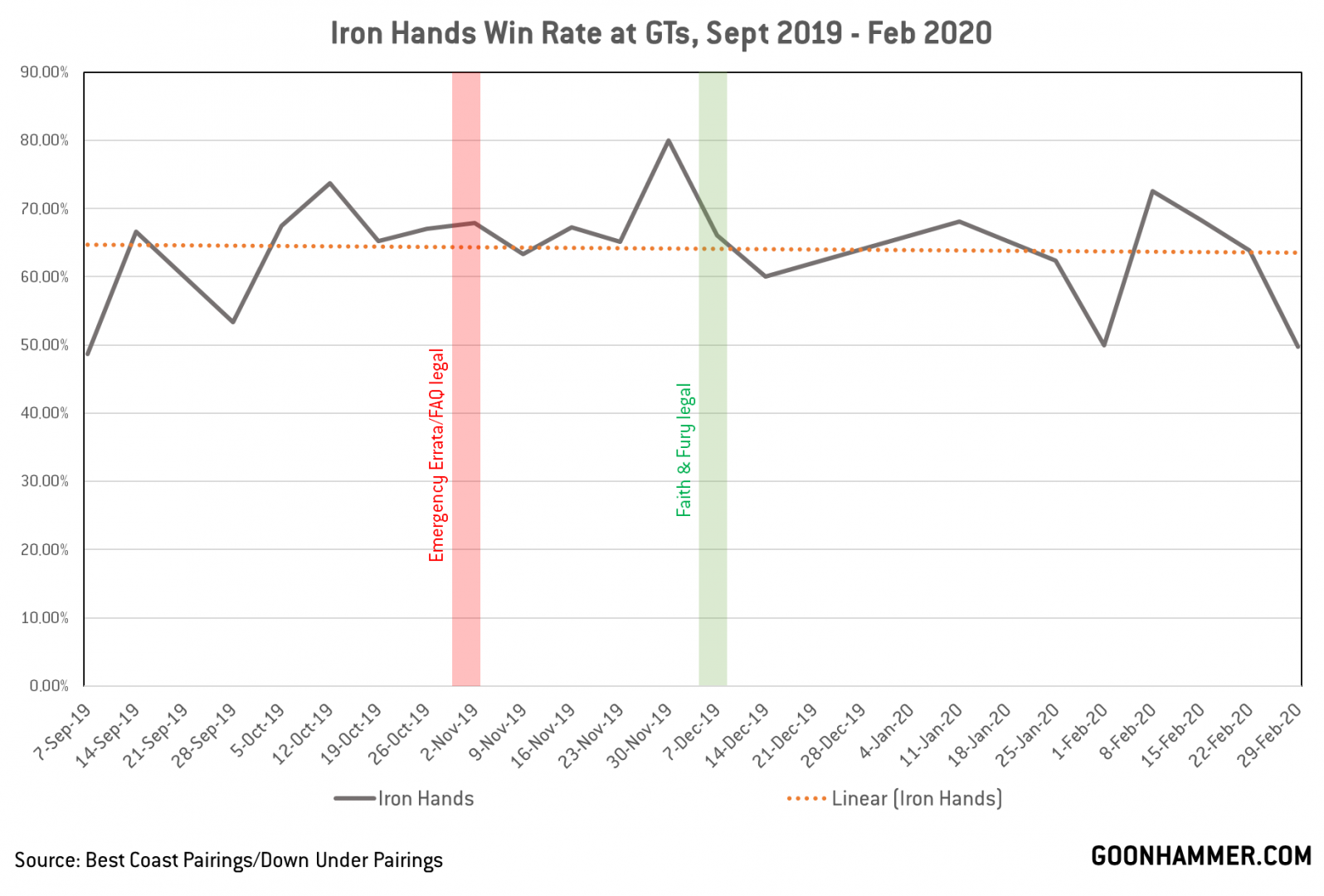
Iron Hands and, to a slightly lesser extent, Raven Guard retained a remarkably stable win rate for nearly six months, dominating events. But why didn’t the meta adapt? Well, there are three key reasons:
1. Other factions just didn’t have the tools to compete.
It was clear when Iron Hands released that other armies just did not have the tools to compete – Iron Hands combined hard-hitting high-AP ranged fire with units that were impossibly hard to kill. On top of that the Iron Hands era saw the release of seven additional codexes and supplements – Phoenix Rising, Faith and Fury, Codex: Sisters of Battle, Blood of Baal, and Ritual of the Damned, giving us new rules and tools for eleven other armies. But ultimately nothing in these books was a big enough boost to make up for Iron Hands’ army-wide durability and ranged firepower, and these updates included major buffs to several factions.
Falcon: It should be noted that there was a good amount of talk in the community when the IH supplement dropped that this might be the start of something new, a turning point in how the game was being developed, with the rest of the factions balancing out when their Psychic Awakening updates were released, but it became apparent early on that while these books were mostly excellent and much-needed updates to beloved factions, they didn’t pass muster next to Marines – particularly once Faith and Fury showed that Marines were getting their own additional facelift anyway with new chapter command upgrades.
2. Top players adjusted to the Iron Hands meta by playing Iron Hands.
Often when players say “the meta will adjust,” they are implying that players will adjust by finding ways to beat new top armies with other armies or strategies. However what they don’t account for is that when an army is particularly dominant, the optimal strategy for top players is just to switch to that army. And that’s exactly what happened during Iron Hands winter.
Outside of holiday weekends that saw a very small number of tournaments being run, Iron Hands adoption increased substantially following the book’s release, and the chapter and its successors made up more than 10% of played armies in early February.
Falcon: This adoption process was made staggeringly clear when an excellent colleague of mine compared Iron Hand adopters’ win rates in the year leading up to the release to their performance in the first 3 months after. Of the 101 players I had data for that made the leap, the bottom 25% went from an average win rate of 31% to a 61%, while the mid-quartiles jumped from a 52 and 62 respectively to a 68%. With numbers like that it’s no surprise that top level players would feel the need to move as well. The top quartile managed to hold steady going from a 77% to 76.5% in the jump.
3. Iron Hands players got to adapt too.
Because obviously they did. “Adapting” isn’t a one-sided process, and when elements of the codex were nerfed in the emergency FAQs and errata or when players attempted to find counters to the list, Iron Hands players adjusted to take advantage of other degenerate strategies to stay on top. The difference is that Iron Hands were already winning 70% of their games in a diverse meta with lots of strategies, and so the chances that a player would create a novel list that would be successful against Iron Hands were slim at best.
This culminated in Adeptus Astartes armies being 27% of the field at LVO 2020, and of those 45% were Iron Hands lists. Iron Hands made up a staggering 32% of all lists that started 4-0 while the average first loss for Raven Guard lists was after 3.1 games. It was no surprise then that Marines took 5 of the top 8 spots at the tournament and Iron Hands took the top spot. Richard Siegler, following an unprecedented run with T’au in late 2019 to win NOVA, PTT Atlanta, Warzone: Atlanta, and the Armageddon Series, then switched to Iron Hands to win LVO and secure his place as the top ITC player for the 2019 season. When interviewed about his win, he had this to say:
I was … helping my teammates John Lennon, Ruben Fernandez and Rich Martin in designing an Iron Hands list for LVO and within several iterations we found a variant that I didn’t believe I could beat with T’au.
– Richard Siegler, February 2020
Looking Back on the Castellan Meta
 Falcon: When I began collecting data back in July of 2018, we were just beginning to see what would become a great spike in GT and Major play around the world. It just so happened that my start also coincided with the creation of what would become one of, if not THE most meta-defining units of the last 2 editions. In June 2018, codex Imperial Knights dropped and was the talk of the town. People were drawn pretty quickly to House Taranis’ “Zombie” knights, House Raven and House Krast’s firepower and House Terryn’s speed. It would be at BAO 2018, the first Major after their release (and the first event I would cover), that we would see what might be a problem. What would become known as ‘the Mitch Pelham list’ and later just ‘the Castellan list’ would see play for the first time on stream at BAO and despite losing that game it would be clear that it was just the biggest coagulation of degeneracy one could think of.
Falcon: When I began collecting data back in July of 2018, we were just beginning to see what would become a great spike in GT and Major play around the world. It just so happened that my start also coincided with the creation of what would become one of, if not THE most meta-defining units of the last 2 editions. In June 2018, codex Imperial Knights dropped and was the talk of the town. People were drawn pretty quickly to House Taranis’ “Zombie” knights, House Raven and House Krast’s firepower and House Terryn’s speed. It would be at BAO 2018, the first Major after their release (and the first event I would cover), that we would see what might be a problem. What would become known as ‘the Mitch Pelham list’ and later just ‘the Castellan list’ would see play for the first time on stream at BAO and despite losing that game it would be clear that it was just the biggest coagulation of degeneracy one could think of.
Combining Astra Militarum and Blood Angel command point regeneration (which at the time could stack), Blood Angel Thunder Hammer captains, 9 of the aggressively costed Artemia Pattern Hellhounds and the House Raven Knight Castellan created a list that would start the game with 13 command points and often gun through 27 by the time the game ended with some to spare.
This specific list would boast an almost 80% win rate over the month it was allowed to live ‘as is’ as it would end up being adopted almost in its entirety by some 28 players that were more than capable of piloting it to 4-1 and 5-0 records. While Imperial Knights as a whole would flit between a 53 and 56% win rate over nearly the entirety of their run in 8th edition, and take up roughly 12% of lists (or over 20% when you counted lists that brought 1 as an ally) until the launch of Space Marines 2.0, it was the House Raven Castellan that warped the meta. At LVO 2019, in a field of just over 600 people, 78 Castellans made an appearance. At one time the Raven Castellan alone provided a 6%-7% gross lift in win rate to the Astra Militarum faction as a whole (Primarily Guard armies held a 56% win rate during the ‘reign’ of the Castellan, but only a 49% without the Castellan to prop them up). After seeing nerfs to CP regeneration, the FLY special rule and their core stratagems, the Castellan lists ended up just evolving to follow suit, swapping out captains for Bullgryn or other fare. Here’s a snapshot of how the Castellan did in the 10 months it had in the sun.
![]() Rob: It’s difficult to overstate how meta warping the Castellan was. Not only were it and the soup lists built around it mainstays of top 4s at events, it also made the majority of vehicles completely unusable in competitive 40k since they could be reliably destroyed on the first turn of the game by a Castellan Knight. The Castellan nearly single-handedly invalidated an entire class of units in 40k.
Rob: It’s difficult to overstate how meta warping the Castellan was. Not only were it and the soup lists built around it mainstays of top 4s at events, it also made the majority of vehicles completely unusable in competitive 40k since they could be reliably destroyed on the first turn of the game by a Castellan Knight. The Castellan nearly single-handedly invalidated an entire class of units in 40k.
If you go back and look at old Hammer of Math articles from 8th edition, you’ll see that every article about a unit’s damage output looks at their ability to destroy a Knight. There’s a reason for that.
Fixing the Problem
![]() Wings: So, this is the long version of the arguments I presented yesterday in my editorial.
Wings: So, this is the long version of the arguments I presented yesterday in my editorial.
40K has a massive number of options and moving parts, and there often genuinely is room for armies to adapt, especially if some new top dog is especially vulnerable to some categories of threats. Sometimes using the best tools in the book opens you up to a rough matchup, and the “unfair” builds stay on the shelf. Sometimes the whole is also just that bit less than the sum of its parts. Changes made too rapidly can also either go too far or address the wrong thing, and I strongly suspect the absurdity of segueing from the kneejerk Commissar nerf after the 8th Guard book was released straight into the Tyranid codex with giant blocks of fearless infantry still weighs on the designer’s minds.
Issuing a rapid nerf is also not a cost free exercise even if you get things right. Quite apart from the basic logistical cost of compiling and translating it, turning around and telling players that the new toys they bought a month ago are less good now is bad for consumer confidence. Why buy something that looks exciting on paper if you aren’t sure it’ll still be worth your time and painting investment in a few weeks? It’s also disproportionately harmful to casual players’ experience of the hobby. If you’re reading this, you’re likely to be a relatively highly engaged player, eagerly devouring every new pronouncement from the GW FAQ page, but there are large parts of the community, generally not nearly as well represented in The Discourse, who don’t want to find out their book is wrong already because of what those WAAC tournament bastards have gotten up to, or worse be told they’re “cheating” in a pick-up game because they hadn’t got the memo yet. While the competitive community is very loud online, the hobby belongs to those players too, and their experience needs to be part of the calculation of when an FAQ is issued.
Sometimes, however, the situation ends up so absurd that the costs of doing something have to be paid, and Drukhari have soared past that threshold. Following up last week’s spectacular hit rate of GT wins with 5 (arguably 6) out of 8 top spots in an event that wasn’t miles short of a supermajor, all while hitting 70%+ win rates in non-mirror matches is absurd. As outlined above, this has no precedent since Iron Hands, and I think it’s very tough to look back on how that played out and say “yes, we should wait and see on this”.
This also isn’t confined to the competitive scene. Even on the casual/competitive borderline, confronting an army as over-pushed as Drukhari with a weaker faction can be plain unfun, and worse Drukhari players, who to be clear aren’t at fault here, can find people not wanting to game with them because of the faction being seen as “too good”. This effect tends to have a long tail too – I still routinely hear stories of more casual players getting told they’re powergaming for playing some flavours of Marines long after they’ve fallen out of favour in the competitive scene, and Drukhari could easily be next to join that rogue’s gallery. Among the less positive comments on yesterday’s piece people are still complaining about Eradicators, which a.) haven’t been anywhere close to overpowered for months and b.) have been nerfed twice since Indomitus. The longer Drukhari stay a problem, the worse any impacts such as this are going to be, and maining a faction that has that kind of rep sucks.
With that in mind, the final consideration is whether there is any chance of things resolving themselves in good enough time without GW making changes, and I’m comfortable at this point that the answer is “no”. The meta is not going to adjust – or it will, but only in the form of all the best players switching to Drukhari as fast as they can paint, as is already pretty evident and happened before with Iron Hands.
Drukhari are too powerful on too many angles for the meta to adapt to them – you need to be turning up with a list that’s exceptionally well tuned to defeating them just to have a chance at winning games, and even then the odds are against you. Looking at the records of the top non-Drukhari players at Dallas shows a repeated pattern of the other top armies taking out the rest of the field, but then picking up their losses against Drukhari. The very best performers managed some wins against Drukhari, but then picked up a loss in a later round, and these are some exceptional players running armies they’ve been using for ages against Drukhari pilots who have at most a month of practice. There are probably still slivers of win percentage to be eked out as players grasp at straws (I imagine Marine lists are going to converge on triple VolCons as fast as Forge World can produce them) but not enough to change the fundamental truth at play here.
The final argument I’ve seen against changing Drukhari is that the new AdMech book is somehow going to “fix” them, to which I say – I’ll believe it when I see it, and I don’t think we can wait. Part of the reason Drukhari are so busted is that mobility is a core part of their faction identity, and mobility is king in 9th’s missions. AdMech shooting definitely is some of the best in the game at killing Drukhari, but if the shooting in the new book is so good that if can overcome Drukhari’s board control advantage, then frankly the arrival of the new book is just going to trade one big problem for two. It is also at minimum now three more weekends before any new AdMech book can be legal at events, and three more weeks of this with no action taken is going to be miserable – and if the book arrives and turns out not to kick the elves in, is going to be even more disastrous. If it does? Review any changes – explicitly badge anything you do now as an “emergency” update, and say you’ll monitor the situation as new codexes arrive. Done.
I love winning with space elves, but I love a diverse, healthy competitive scene more, and change is needed to preserve that.
What Happens if There’s No Emergency Errata?
![]() Rob: So what should be done? We’ve talked about this at length as well, but essentially the options boil down to “making an emergency balance adjustment” versus “doing nothing and hoping things shake out.” We’ve already examined how and why we don’t believe the meta will be able to adapt to this, but what if Games Workshop opts to do nothing and leave Codex: Drukhari as it is?
Rob: So what should be done? We’ve talked about this at length as well, but essentially the options boil down to “making an emergency balance adjustment” versus “doing nothing and hoping things shake out.” We’ve already examined how and why we don’t believe the meta will be able to adapt to this, but what if Games Workshop opts to do nothing and leave Codex: Drukhari as it is?
The key rationale behind not taking actions appears to be that the immediate future releases – Codex: Adeptus Mechanicus, Codex: Adepta Sororitas, and (presumably) Codex: Orks – will balance things out by dampening the impact of Codex: Drukhari. In that sense, we need to consider how strong the Adeptus Mechanicus codex will be and whether they’ll match up well against Drukhari. If the codex is weak, or doesn’t match up well against Drukhari, then we can safely say that it won’t likely have an impact on the meta. On the other hand, what if Codex: Adeptus Mechanicus is as good as the Drukhari Codex, and posts a 70% win rate across the board, serving as an effective counter to Drukhari in the process? This is much more likely than Admech being able to win consistently against Drukhari while also losing to other factions, and from some of the previews we’ve seen of weapon upgrades, it doesn’t appear their weapons are getting worse.
So let’s assume a new Adeptus Mechanicus codex comes out that’s on the same level, power-wise, as Codex: Drukhari, but able to consistently beat them. We know from past analyses that a new book leads to an increase in share of games for a faction, and we can also project increases in games based on last year’s data, which showed an increase of games prior to COVID-related shutdowns. The resulting meta looks something like this:
This projection has AdMech doubling in size as a faction in terms of games played (something we’ve seen happen with past codexes), Drukhari are pushed down to a 64% win rate based on losing 70% of their games to AdMech, and everyone else drops by a little bit, leaving us with four factions that post win rates above 50%. If Codex; Sisters of Battle does the same thing, we end up with a similar situation, pushing out Harlequins from the “above .500 club.” And likewise for Orks if it’s on the same level, creating a meta where the four most recent factions have 60%+ win rates and the rest are sub-50%. Now you may suggest that many factions have yet to receive 9th edition updates, so they’ll be fine – but note that as this happens, Marines, Necrons, and Death Guard will be left far behind.
Granted, this is pretty extreme, but it’s a plausible outcome if the solution to Drukhari balance is to release a series of codexes that are on the same level of strength, competitively.
![]() Wings: This doesn’t look like a healthy future to me, and one particular thing I’d like to highlight is that on some level, the numbers at the very top here are even less fun than they look, because they hide the differential between first and second turn win rates. Drukhari have been cruising at ~80% GFW, and I’d expect AdMech with shooting good enough to beat Drukhari to do something similar, and that’s just catastrophic. Book a hotel room and drive for hours to get to an event, lose the roll-off game 1 and know that you’ve only got a one in five chance of winning? People are going to get bored of that real, real fast.
Wings: This doesn’t look like a healthy future to me, and one particular thing I’d like to highlight is that on some level, the numbers at the very top here are even less fun than they look, because they hide the differential between first and second turn win rates. Drukhari have been cruising at ~80% GFW, and I’d expect AdMech with shooting good enough to beat Drukhari to do something similar, and that’s just catastrophic. Book a hotel room and drive for hours to get to an event, lose the roll-off game 1 and know that you’ve only got a one in five chance of winning? People are going to get bored of that real, real fast.
What the Hell Happened to Dark Angels?
![]() Rob: When Codex: Dark Angels released, there was a lot of talk about where they’d slot in and how well the faction would perform. With two incredibly easy secondary objectives to score in Death on the Wind or Stubborn Defiance, some great, fast units, and the ability to take Deathwing Terminators with Objective Secured who could only be wounded on a 4+, Dark Angels seemed poised to move up into the upper Tier 2/lower Tier 1 of 40k factions.
Rob: When Codex: Dark Angels released, there was a lot of talk about where they’d slot in and how well the faction would perform. With two incredibly easy secondary objectives to score in Death on the Wind or Stubborn Defiance, some great, fast units, and the ability to take Deathwing Terminators with Objective Secured who could only be wounded on a 4+, Dark Angels seemed poised to move up into the upper Tier 2/lower Tier 1 of 40k factions.
Well, the first thing to note is that Dark Angels did get a bump from their new book – they jumped from a 49% win rate prior to the release of their book at the beginning of February to a 51% over the last two months and likewise their Glicko2 Scores have risen over the last two months as well. A Dark Angels list won the Western Australia Ironman GT in late March, and Dark Angels lists made the top 4 of five different GTs between late February and early April.
On the other hand, a 51% win rate puts them nearer to the middle of the pack among factions, and they’ve been absent from top 4s since early April. It’s still among the top Marine factions, however – on par with Space Wolves, the other top Marine faction.
Four major factors work against Dark Angels moving further upward, however:
- Incremental improvements. While Codex Supplement: Dark Angels certainly improved the faction, many of its key features – most notably Inner Circle – were already in place with the Index released last fall. This means that the faction’s improvements weren’t as dramatic as those for Death Guard or Drukhari.
- Tournament shortages. There were very few tournaments run in February, leading to a much slower meta development than we saw following the release of the Drukhari codex. This means fewer opportunities for Dark Angels to shine and less development of powerful lists.
- They’re still Marines. The Dark Angels are likely among the best factions of Space Marines, but they’re still Marines, and subject to the same limitations – armies that do well against Marines will still do well against the Dark Angels.
- Drukhari. Simply put, the Drukhari are so good that they’re warping the meta and it doesn’t help that Inner Circle doesn’t help that much against poisoned weapons and widely available wound re-rolls.
![]() Wings: My big takeaway from looking at Dark Angels lists that did and didn’t succeed is that the early builds went too hard on Deathwing. I have been consistently skeptical that Stubborn Defiance was ever quite as good as it looked, and it’s ended up being very binary. You definitely turn up to some games with it in play and it’s a free 15, but those aren’t really the games that are at risk of running close. This kept the very heavy Deathwing lists that people tried out the gate down.
Wings: My big takeaway from looking at Dark Angels lists that did and didn’t succeed is that the early builds went too hard on Deathwing. I have been consistently skeptical that Stubborn Defiance was ever quite as good as it looked, and it’s ended up being very binary. You definitely turn up to some games with it in play and it’s a free 15, but those aren’t really the games that are at risk of running close. This kept the very heavy Deathwing lists that people tried out the gate down.
What seemed to work much better, and that people had pivoted to, are builds much heavier on Ravenwing. The true breakout strength of the book appears to have been the addition of Jink to codex imports like Attack Bikes and the Death on the Wind secondary. Packing a few big Terminator units with Ravenwing to range around the edges seemed to be playing much better, and was starting to pick up decent results, if still not quite what we originally anticipated.
Unfortunately, Drukhari kill these lists stone dead. The Raiders are far too resilient to chip damage, and the individual Ravenwing units are far too vulnerable to being picked off one by one. Once they’re out the way, Drukhari can either coast to victory by largely ignoring any residual Deathwing bombs, or brutally detonate them if they still have resources left. For Marines to have any chance at all against Drukhari, it looks like they need to be packing fast, flying melee units, and the complete lack of specialist support for these in Dark Angels, and indeed not being able to take Vanguard Veterans at all, appears to count them out for now.
Next Week: A Quick Update on Subfactions, Secondaries, and Go First Win Rates
That does it for this update, which we’ll end here in the interest of having something that doesn’t spiral out of control length-wise (yes, I am aware that it is already too late for that). But stay tuned for next week, when we look at some additional odds and ends that were interesting, but didn’t so much fit with this week’s analysis. Specifically we’ll be looking at some key subfactions like Plague Companies, find out who the strongest Marine chapter is, look at faction secondaries, and take another look at whether go first win rates have changed.
Until then, if you have any questions or feedback, drop them in the comments below or email us at contact@goonhammer.com.
